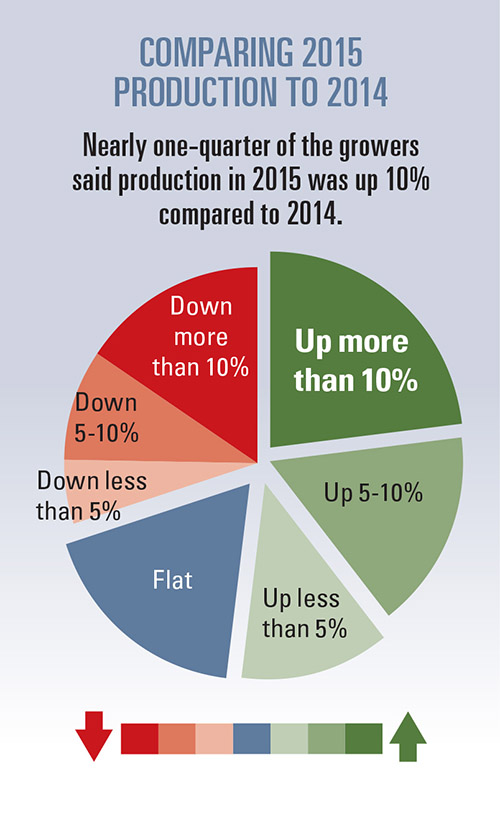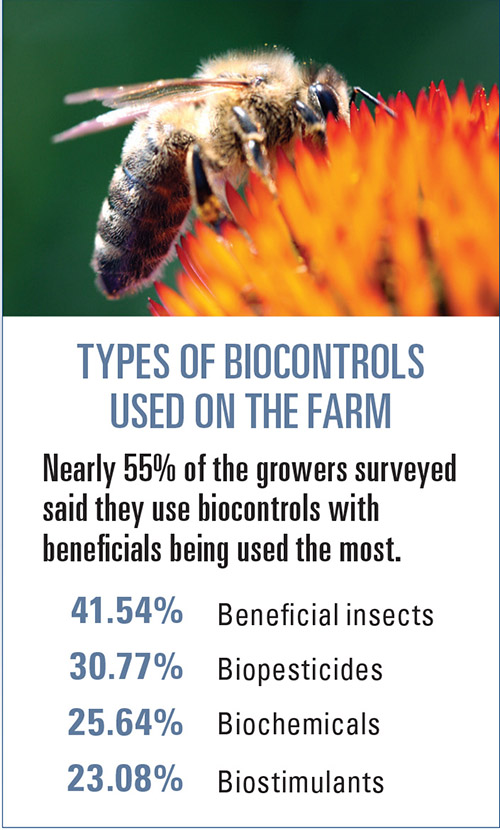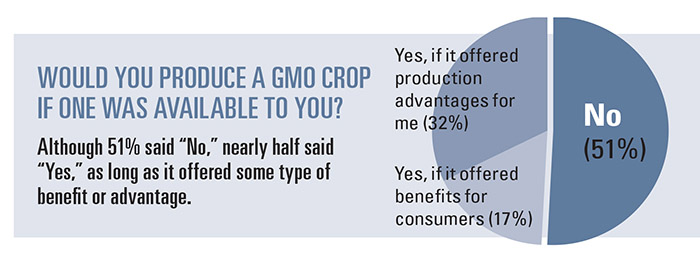State Of The Vegetable Industry Survey Shows Growers Optimistic About 2016
If American Vegetable Grower® magazine could sum up in four words what was learned from its inaugural State of the Industry survey, those words would be: Things are looking up.
In spite of the drought, concern over government regulations, rising production costs, and finding labor, many growers said they plan to increase or keep production the
same in 2016.
Just who took the survey? Of the 400-plus respondents, the list, in addition to growers, includes industry suppliers and research and Extension folks.
Of the growers who responded, two-thirds produce on less than 200 acres, and about half have an annual sales volume of less than $100,000. Plus, these farms are staples in the industry as nearly 35% have been in business between 25 and 50 years.
As growers are optimistic by nature, it comes as no surprise that many plan to either increase production or keep their acreage the same this year.

 Half said production in 2015 was up compared to 2014, and about 25% said production was up 10% over 2014 numbers. About one-third said they plan to increase crop production in 2016 while more than half plan to keep production on par with 2015 numbers.
Half said production in 2015 was up compared to 2014, and about 25% said production was up 10% over 2014 numbers. About one-third said they plan to increase crop production in 2016 while more than half plan to keep production on par with 2015 numbers.
Plans to increase production go hand-in-hand with plans to invest this year. Key areas of grower investment will be in plant health, specifically crop protection, plant nutrition, and soil amendments. Other areas growers plan to invest include crop management, greenhouses, irrigation equipment, and seed.
Protected Ag And Biocontrols
Two areas where survey respondents see production advantages involve the use of protected growing structures and the use of biocontrols.
When asked about growing under cover, around half of the respon-dents said they use a greenhouse, high tunnel, or low tunnel. More than 90% of the growers who use greenhouses produce on less than 5 acres. Tomatoes are still the top crop in greenhouse production followed by peppers, cucumbers, and leafy greens.
If anyone ever doubted the role of high tunnels in vegetable production, however, our survey results indicate the structures are here to stay as more than 25% of respondents are using them. The list of crops being produced in high tunnels is quite extensive, too, including tomatoes, spinach, peppers, leafy greens, cucumbers, strawberries, cole crops, celery, carrots, and beans — just to name a few.
For low tunnel production, the crop list is not nearly as extensive. Tomatoes are a smaller percentage of crops produced when compared with high tunnels, but the crops taking up the most space in low tunnels include leafy greens.
Those who don’t use a protected ag structure now, however, don’t have plans in the future to add one. More than 80% said they will not add a greenhouse, high tunnel, or low tunnel to their operation.

Growers also are seeing the benefit of using biocontrols. Beneficial insects, biostimulants, biopesticides and biochemicals all fall under the biocontrol heading and quite a few respondents are currently using these products, nearly 55% to be exact. This lines up with the move in recent years to softer chemistries, which help to simplify the export process and meet Maximum Residue Limits.
The largest segment of those who are using biocontrols said they use beneficial insects (42%). Biopesticides were next on the list with 31%. More than 25% use biochemical products, which include plant extracts and plant growth regulators, and 23% use biostimulants, which are biological products that focus on plant health.
Tactics To Increase Profits
When asked about the specifics on how growers increased profits in 2015, the responses went from getting more equipment and reducing fertilizer costs to selling to high-end restaurants and partnering with additional CSAs, to employing better cultural practices and making improvements to marketing practices.
For example, one grower said he cut labor costs by using upgraded equipment. Another said he put all of the farm’s tomato production on plastic and drip to boost profits.
Others mentioned the use of beneficial insects and better timing when applying them and when planting.
One grower highlighted three things to help increase profits. “1) Held off on production for a week until prices went up. 2) Transplanted more acreage and more crops. 3) Lucky enough to hit some good markets for three to four crops.”
At the end of the day, however, one researcher provided some advice that cuts across all aspects of production. “If you don’t have a market, you just have a hobby. Determine what your market is and how you will meet it before you put anything in the ground.”
Now that’s sound advice.
The GMO Question
Of the growers who responded to the question: Would you produce a GMO crop if one was available to you? The answers may come as a surprise.
About 51% said no, they would not grow a GMO crop, but the other 49% are willing to consider the option, given a few stipulations.
About 32% said they would grow a GMO crop if it offered them production benefits. Moving away from production advantages, 17% said they would produce the crop if it provided benefits for consumers.

Researchers Respond
It’s not really a surprise that those on the research and Extension side share virtually the same concerns as growers. In addition to government regulations and production costs, other topics causing researchers to worry include access to varieties, new invasive pests, and having enough pest control options available.
On the positive side, however, they are seeing some trends that will fill niches, and potentially help grow markets. Check out what a few had to say:
“We are seeing restaurants expand and starting to look for local produce. Local chefs can be seen at the Saturday market and local growers are taking advantage of it. Asking questions to decide what to include in the next crop plan.”
– Louisiana State University researcher
“There is continued interest and construction of controlled environment agriculture from low-tech tunnels to sophisticated greenhouses and everything in between.”
– Penn State University Extension researcher
“There is demand for organic growing, yet our region is challenging. Plun, there is a Need for rotation aspects for organic and thus careful marketing.”
– Researcher from the Northeast
“More small part-time growers getting involved in production.”
– Researcher from the University of Kentucky
“More direct-marketing. If migrant problems are not addressed soon, there should be a sudden boom in mechanical harvesting again, which was last attempted in the 1960s.”
– Penn State University professor emeritus
Dealing With Budget Cuts
In recent years, Land Grant University budgets have been slashed and the fallout is still being felt by researchers. To combat those cuts, researchers have continually hunted for funding for their respective projects, which takes them away from dealing with growers’ problems. According to our survey results, many are still fighting this battle as more than one-third say they have increased the amount of time they have devoted to getting money lined up to conduct research.

Suppliers Anticipate 2016 Will Be A Good Year
As 2015 was a better year for those supplying vegetable growers than 2014, the hope is 2016 will be even better. Many suppliers said their sales in 2015, in general, were better than 2014.
More than 30% the industry suppliers who responded to the survey said sales were up at least 10% over 2014, and nearly 24% said sales had increased between 5% and 10% from the previous year.
For 2016, more than 32% predict sales will be up more than 10%, and 28% said sales will jump between 5% and 10% over last year. Plus, nearly 46% said prices will be up, too, between 1% and 5% higher than 2015.

Much like growers, however, suppliers have similar concerns in 2016. Issues with increasing regulations, water, and the economy also plague the supply side.
Offering some words of advice to help growers increase profits this year, here’s what a few vendors had to say:
“Consider using organic soil amendments to improve soil tilth and overall plant growth, regardless of whether or not the grower is certified organic.”
— Vendor from the Southeast
“Embrace case level traceability. It protects [growers] in recalls and helps eliminate the need for commodity-wide recalls.”
— Supplier from the West
“Use appropriate fungicides at planting or transplanting to improve stands and crop uniformity.”
— Supplier from the Southeast
Trending In 2016
Suppliers also said organic production, high tunnel use, the locally grown movement, and implementing the use of biocontrols are some of the trends that will continue to propel us forward in 2016.
Homing in on the biocontrols topic, a Midwestern supplier mentioned the general introduction of beneficial microbial products and how this category is expected to grow.
The trend toward healthy eating also was noted. In fact, one supplier from the Southwest said: “More people are finally realizing that their health is most important, and fresh produce is the key to healthy living.”
A Northeast vendor had something similar to say: “We will continue to see an increase in awareness of health benefits of vegetable consumption, and an increase in vegetable consumption.”
To help growers offer more vegetables to the consuming public, suppliers also will strive to help them increase yield and efficiency. They also noted the continued need to develop the best varieties and educate growers on the technology available to them.










